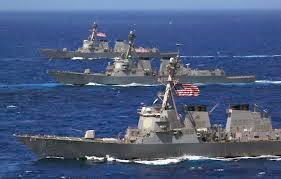Envisioning the Philippine Navy's SeaBees Fleet
The Philippine Navy is set to
acquire two brand new frigates for 18 billion pesos. This will be in addition
to two used Hamilton cutters
recently acquired from the United
States . That would sum to four the
Philippine navy’s frigate fleet by 2018. Before that time and during 2014- 2017
a lot could transpire while the Philippines is in a defense vacuum at sea. The apprehension of many Filipinos is
that the course of Philippine Navy’s acquisition is seemed to be
unresponsive, and patterned after that of the world superpowers whose intent and purpose is relatively more complex.
Destroyers, carriers and frigates
are essential battle equipment of those whose aim is to project power beyond
their borders. These are large and expensive machineries fitted with expensive
electronic devices to enable their operators to export chaos in any part of the
world. Their sheer size and complexity entails more cost in maintenance and operation. These type of ships is
expeditionary, as such, they must carry all the essential weaponry and
equipment to enable them to wage war even at high sea and away from their
logistic source. In contrast and
specifically, the Philippine Navy’s mission is in fact dissimilar, and more appropriately is to protect the national
patrimony and its sovereignty as defined by its border under the constitution
and international law that includes the Philippines 200 miles exclusive
economic zone. The Philippine Navy’s interest and mission requires them to operate
essentially just within, and a little bit beyond the Philippine territorial
boundaries. As such, a doctrine characterized by practicality and effectiveness
must be adapted to serve as a guiding light towards this Philippine Navy’s
mission. The doctrine may necessarily result into the development and
adaptation of tactics, strategy and weapon configurations that may deviate from military
books towards unorthodoxy and veering away... to the non-traditional methodology and modes of territorial defense. In other words, instead of strict adherence with the standard, the Philippine Navy must strive to harness the prize of boldness and if need be, rewrite a new chapter in the navy's history to attain its objective of becoming a genuine and potent force at sea. The primordial consideration should be effectiveness and relevance which must precede cost. With this in mind, the Philippines
must build a naval fleet and support facilities that can effectively thwart an invasion of its territory. It needs to think and act out of the box and re-evaluate the relative feasibility and cost-effectiveness of the traditional concept that an effective navy is only the blue water navy.
The latter is largely for countries that does not only allocate a substantial percentage of its budget to defense, but also sends expeditionary forces to influence
and invade nations. The Philippine constitution restrain the latter action and accordingly, along
that line is where the Philippine military needs to traverse.
The Philippine Navy may adapt the model that gave birth to the Scout Rangers- the Philippine Army’s special force; its motto capitalizes on its weakness and transformed it into strength, “slim but mean, outsized but never outfought”. The Philippine Navy may need to have an equivalent special force at sea that is fast, agile and deadly.
The Philippine Navy may adapt the model that gave birth to the Scout Rangers- the Philippine Army’s special force; its motto capitalizes on its weakness and transformed it into strength, “slim but mean, outsized but never outfought”. The Philippine Navy may need to have an equivalent special force at sea that is fast, agile and deadly.
Much has been written and discuss
about the Philippine’s acquisition of Multi-Purpose Attack Craft or MPAC but
the recent planned acquisition of 3 additional MPAC to the existing
6 of its current inventory shows that the Philippine Navy at least in
quantitative terms has yet to recognize and introduce radical change in its
thinking and philosophy. Of course this writing is not at all meant to step on
the navy’s shoes, but as a concerned Filipino thinker what will be your take on a
Philippine Navy that has the firepower of 3 Arleigh Burke Destroyer for 18
billion pesos, the same price and budget allocated for the planned 2 brand new
frigates? This same amount can buy 180 MPAC which can operate at sea stage 3, exactly the environment of a green water navy. The raison d’etre for the
MPAC is to deliver its payload to enemy ships even up to the edge of Philippine
boundaries and beyond, thus effectively extending the range of any missile defenses.
The MPAC can made to be armed
with; 2 RBS 15 Mk 3 anti-ship missiles, one on each side; a quadruple
anti-air missile at the rear; a triple Brimstone asymmetric missile in front; and
a coaxial cannon or machine-gun on top. Admittedly, the cost of this weaponry is
distinctly separate, but the point as one may already have understood is that having 180 MPAC that can speed-off at 70 kilometers per hour; sprawled and
scattered in formation at the West Philippine Sea; with a combined firepower of
360 anti-ship missile which can hit targets beyond visual range; couple with the ability to launch 720 missiles on any aerial target; augmented with
540 asymmetric missile against short range seaborne target can only be described as “One Hell of a serious Navy”.
Think of these MPAC’s berthed
inside a man-made concrete caves spread along the critical areas of the coastline in a group of seven,
just like a squad of scout rangers, protected from missile attack by natural land
features; that can suddenly blurt out from the safety of their base tunnels to
inflict asymmetric attack upon command; and return to reload and fuel-up in
alternate fashion providing a sustained barrage and havoc to enemy ships
domestic or otherwise. More so, what if you have one thousand of these MPAC.
Of course there will be casualty
and losses, but unlike larger ships like frigates, if you lost four you lose
the battle. In case of the MPAC you lose four you still have theoretically 176
left. A damaged MPAC can easily be repair and less costly to replace for
obvious reason. When one out of the four frigate is damaged and incapacitated you have one less frigate equivalent to a drastic 25% reduction in the navy’s fighting ability. Think about it, think
about what a fully armed sea bees of 1000 MPAC can do or can not do in pursuit
of the Philippine Navy’s mission.
“ Freedom is expensive, it is even paid with lives”.






Comments
Post a Comment